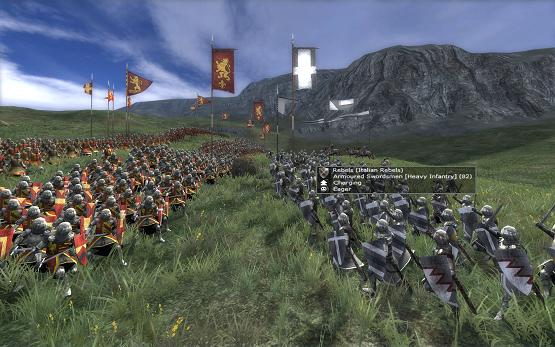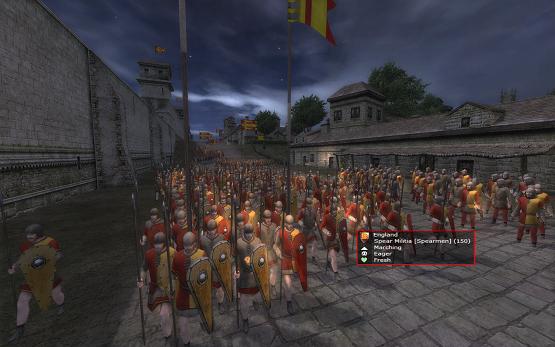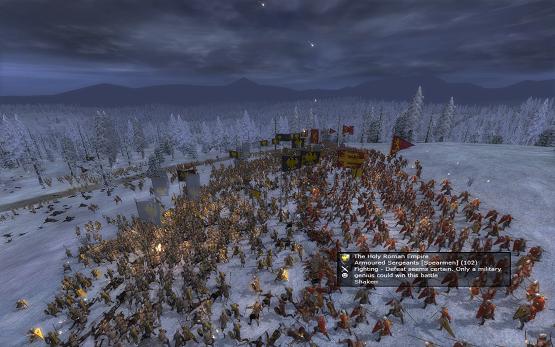
I’ve long had a love-hate relationship with Creative Assembly’s Total War series. On the love side of the equation, the basic formula of a turn-based strategic game coupled with real-time combat, unchanged since Shogun: Total War was released in 2000, is supremely satisfying. The combination of deep decision-making played out on the grand stage of history with a graphically rich and detailed tactical combat phase just scratches all the right strategy itches. At this point, I’d play total war anything. Robotech: Total War? Warhammer Fantasy: Total War? Romance of the Three Kingdoms: Total War? If they’ll make it I’ll buy it.
On the other hand, CA’s failure to update the interface for the strategic portion of the game is an endless source of frustration. It is wholly unacceptable that the Total War games still don’t have the basic tools to streamline gameplay, such as the ability to quickly check which units still have unused movement points, that the Civilization series has had since its inception. This means that actually playing through an epic campaign is unnecessarily daunting and time consuming. Medieval 2 continues this trend and actually adds to it by making the strategic portion more complex compared to previous games. This means that the latest game in the series is epic, beautiful and grand, but, boy, but does it take a long time to actually get through a campaign.
Like the original Medieval, this game focuses on Europe and parts of North Africa and the Middle East while the timeframe has been expanded to include the discovery of the Americas. There are a total of seventeen playable factions in the main campaign, though only five of these, namely England, France, the Holy Roman Empire, the Republic of Venice and the Kingdom of Spain are initially available. The rest of the factions are automatically unlocked once the main campaign is completed or upon defeating that specific faction in a campaign. The game is based on an updated version of the Rome: Total War engine, meaning that everything looks nicer and more polished, but there are no drastic overhauls.

The most significant change is that settlements can now be developed either as cities or castles. Cities are the moneymakers of your faction, containing large populations that can be taxed for revenue and hold the potential to be developed into major trading centres. The downside is that cities can no longer be used to train professional troops and while they still possess walls and towers, their defenses aren’t as strong as those of castles. They’re also prone to unrest and may revolt and so require significant investments in the form of buildings to promote happiness and garrisons to keep under control. Castles are where you raise your best troops and are formidable to conquer given that they have both an outer wall and an inner citadel. They’re also unlikely to revolt but on the other hand, produce very little revenue.
The other big change is that towards the end of the game, you get an event that opens up the New World for exploration. The journey there is pretty arduous though, so it’s a good idea to load up as many troops as you can since it’s unlikely that you’ll be able to send reinforcements quickly. It’s a cool gimmick to add some late game spice to the game but doesn’t really impact the campaign much.
As with every other installment in the series, the strategic portion of the game serves mainly to create situations and provide context for the battles, so it will never be as deep as Civilization. Still, there’s a fair bit that you can do here. In addition to diplomats, spies, assassins, princesses and priests, Medieval 2 adds merchants as an agent on the strategic map. They can be placed on trade resources to provide a steady stream of income or be sent into enemy territory to steal businesses from enemy merchants, provided that their mercantile skill is high enough. Properly micromanaged, they can be a significant source of income but my personal feeling is that they don’t add enough to the game to justify the hassle. I’ve covered religion in the game previously so I won’t repeat that here. Suffice to say that priests are easily the most important strategic unit in the game.

As I mentioned, my main gripe with the strategic map is how cumbersome the late game bloat becomes without the proper tools to manage them. Being able to set units to sleep or sentry mode and being able to cycle through the active ones with movement points would go a long way towards reducing the time spent on playing each turn. Even the beginning of turn reports that you get can’t be reopened once you close them, which is especially annoying when you’ve just loaded a savegame and can’t remember what happened recently in your game. The added complexity of differentiating cities from castles does make the strategic game richer but at the cost of needing even more time to play each turn. One improvement from Rome: Total War is that it’s no longer possible to simply construct every available building in every settlement. Money is tight enough that you need to pay close attention to what is being spent where, adding to the overall challenge.
On the tactical portion of the game, besides added graphical bells and whistles, which admittedly look very nice, it is now possible to have night battles. This is initiated by an army led by a general with the “Night Fighter” trait and as might be expected, penalizes enemy generals surprised by the sudden attack. The pace of combat in toned down from Rome: Total War which many people criticized for being too fast and too close to being an RTS game, but still works the same as previous Total War titles. One change I appreciated is that generals no longer lead a wedge-formation cavalry charge from the very tip of the wedge, frequently leading them to be the first to die. The pre-battle speech sequence has been retained from Rome and greatly expanded upon as I noted previously.
I’ve also noticed that the auto-resolve option has changed. Previous games penalized the player heavily when opting to use auto-resolve option, but the penalty seems to be greatly reduced in Medieval 2. In particular, I’ve found that assaulting a settlement using the auto-resolve option actually results in less casualties than if I played the battle out normally. In my game at least, this meant an end to prolonged sieges. An attacking army would besiege a settlement, spend a turn building siege engines and immediately attack the settlement the very next turn. Since this means that a besieged settlement has little chance of getting reinforcements in time, every settlement near the frontline now needs significant garrisons to resist invasions, a change that I personally dislike.

One frequent complaint that I’ve read is the quality of the AI. While it’s true that the AI does use its troops in a less than optimal fashion in battles, in particular being perfectly happy to stand and be slowly whittled to death by arrows rather than charge an enemy force, I’ve found the challenge it provides more than adequate. The AI for example can and will build huge stacks of troops to attack you and is even capable to sending multiple stacks to support each other. In battle, I’ve found it to be smart enough to pull off things like setting a unit of spearmen to slowly march towards my general’s cavalry while I’m trying to use it to flank the main enemy force. During sieges, they will use long range trebuchets and other siege engines to destroy your walls and towers before sending in the infantry and will even move the siege engines when necessary to take out other towers.
In today’s highly competitive games market, it’s a little surprising that no one has tried to mimic CA’s success with the Total War series. With Empire due next year, it’s clear that the Total War is going to hold the crown for historically faithful, graphically detailed strategy games for a while yet. No other game can yet match it for cramming thousands of troops on a single battlefield, so even if I’m still somewhat resentful that CA chose to remake Medieval rather than try something new sooner, there’s not a single doubt that this is a game that’s going to stay on my harddrive for a long, long time.
One thought on “A Game: Medieval 2”